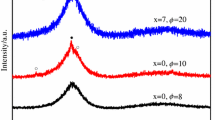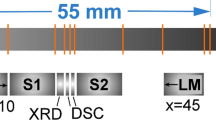Abstract
Bulk glass formation of the Co–Cr–Mo–C–B–Er alloy system was investigated in this paper. The Co50Cr15Mo14C15B6 (at.%) alloy could be cast into fully glassy rod with a diameter up to 2 mm. By adding 2 at.% Er to this alloy, the critical diameter for glass formation reached 10 mm. The excellent glass formability of the Er-doped alloy was mainly attributed to its relatively large reduced glass transition temperature of 0.61, near-eutectic composition, and the necessity of redistribution of the Er atoms for precipitation of crystalline Co6Mo6C phase in the undercooled liquid on cooling.
Similar content being viewed by others
References
D. Turnbull: Under what conditions can a glass be formed. Contemp. Phys. 10, 473 (1969).
Choi-H. Yim, R. Busch, W.L. Johnson: The effect of silicon on the glass forming ability of the Cu47Ti34Zr11Ni8 bulk metallic glass forming alloy during processing of composites. J. Appl. Lett. 83, 7993 (1998).
B. Zhang, D.Q. Zhao, M.X. Pan, W.H. Wang, A.L. Greer: Amorphous metallic plastic. Phys. Rev. Lett. 94, 205502 (2005).
Z.P. Lu, C.T. Liu, J.R. Thompson, W.D. Porter: Structural amorphous steels. Phys. Rev. Lett. 92, 245503 (2004).
V. Ponnambalam, S.J. Poon, G.J. Shiflet: Fe-based bulk metallic glasses with diameter thickness larger than one centimeter. J. Mater. Res. 19, 1320 (2004).
A. Inoue, B.L. Shen, H. Koshiba, H. Kato, A.R. Yavari: Ultra-high strength above 5000 MPa and soft magnetic properties of Co–Fe–Ta–B bulk glassy alloys. Acta Mater. 52, 1631 (2004).
W. Kraus and G. Nolze: Powder cell for powder pattern calculation and profile fitting, version 2.3. Available from: http://www.ccp14.ac.uk. Accessed June 2005.
A. Gebert, J. Eckert, and L. Schultz: Effect of oxygen on phase formation and thermal stability of slowly cooled Zr65Al7.5Cu17.5Ni10 metallic glass. Acta Mater. 46, 5474 (1998).
X.H. Lin, W.L. Johnson: Formation of Ti–Zr–Cu–Ni bulk metallic glasses. J. Appl. Phys. 78, 6514 (1995).
D. Wang, Y. Li, B.B. Sun, M.L. Sui, K. Lu, E. Ma: Bulk metallic glass formation in the binary Cu–Zr system. Appl. Phys. Lett. 84, 4029 (2004).
H. Men, W.T. Kim, D.H. Kim: Glass formation and crystallization behavior in Mg65Cu25Y10-x Gdx (x = 0, 5, 10) alloys. J. Non-Cryst. Solids 337, 29 (2004).
A.F. Well: Structural Inorganic Chemistry (Oxford University Press, Oxford, UK, 1984), p. 1382.
F.R. de Boer, R. Boom, W.C.M. Mattens, A.R. Miedema, A.K. Niessen: Cohesion in Metals (North-Holland, Amsterdam, The Netherlands, 1989).
M. Widom, M. Mihalkovic: Stability of Fe-based alloys with structure type C6Cr23. J. Mater. Res. 20, 237 (2005).
Author information
Authors and Affiliations
Corresponding author
Rights and permissions
About this article
Cite this article
Men, H., Pang, S.J. & Zhang, T. Effect of Er doping on glass-forming ability of Co50Cr15Mo14C15B6 alloy. Journal of Materials Research 21, 958–961 (2006). https://doi.org/10.1557/jmr.2006.0109
Received:
Accepted:
Published:
Issue Date:
DOI: https://doi.org/10.1557/jmr.2006.0109




